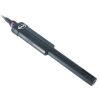Hach Certified OIML Conductivity Standard Solution
Certified Conductivity OIML Standard Solution with Certificate of Conformity and Traceability.
Features
- Accredited Calibration Laboratory
- Fully Traceable Standards
- Expedited repair and warranty service
- Lifetime technical support
- More
Certified Conductivity OIML Standard Solution with Certificate of Conformity and Traceability* reporting exact conductivity value with related expanded uncertainty (k=2). guaranteed shelf-life thanks to premium aluminium packaging. 0.01 Demal Potassium Chloride (KCl) Conductivity: 1408 µS/cm ±0.5% (k=2) at 25°C, 500mL bottle.
*Available for download from www.hach.com: Support/Service, Certificate of Analysis menu using product part number and lot number.
Concentration: 1408 µS/cm ±0.5 % at 25°C
Concentration 2: KCl 0.01D
Description: Conductivity calibration solution
Formula: KCl
Method Name: Standard solution verified by Reference Materials Laboratory
NIST Traceable: Yes
Package Type: Bottle
Parameter: Conductivity
Platform: Solution
Quantity: 500 mL
Shelf Life: 24 months from date of manufacture.
Special Remarks: Observed shelf life after opening, following recommended storage and use: 3 months
Storage Conditions: 10 - 25 °C (protect from light)
In The News
Monitoring Mariculture in the Gulf of Alaska
The mariculture industry in the Gulf of Alaska has been steadily growing in recent years, guided by ongoing research to help refine farm location and cultivation practices. A subset of aquaculture, mariculture focuses on rearing organisms in the open ocean. In Alaska, finfish farming is illegal, so most farms cultivate kelp, oysters, or a combination of the two. These small, locally operated farms started popping up in the Gulf of Alaska in the early 1990s, when shellfish farming first became legal. Kelp farming did not begin to catch on in the state until 2016. Many of the coastal areas that have grown interested in mariculture are historically commercial fishing communities.
Read MoreSupplying Seattle’s Drinking Water: Using Data Buoys to Monitor the Cedar River Municipal Watershed
Providing clean, safe, and reliable drinking water for the 1.6 million people in the greater Seattle area is a top priority for Seattle Public Utilities (SPU). With limited water supplies, SPU dedicates considerable resources to maintain its watersheds and mountain reservoirs. About 70 percent of Seattle Water comes from the Cedar River Municipal Watershed , and the other 30 percent comes from the South Fork Tolt River Watershed . [caption id="attachment_39574" align="alignnone" width="940"] Data buoy in Chester Morse Lake . (Credit: Kevin Johnson / Seattle Public Utilities) [/caption] Jamie Thompson, a fisheries biologist at SPU, monitors aquatic ecosystems centered on fish listed under the U.S. Endangered Species Act (ESA).
Read MoreData-Driven Advocacy on the Lower Deschutes River
Like many freshwater environments, the Deschutes River in Oregon is under pressure from development, pollution, and climate change. Many rivers, streams and lakes in the Deschutes Basin do not meet Oregon water quality standards –where state water quality monitoring assesses levels of bacteria, pH, dissolved oxygen, temperature, and fine sediment. Hannah Camel is the Water Quality Coordinator for the Deschutes River Alliance (DRA), a non-profit organization that focuses on the health of the lower 100 miles of the Deschutes River–the area most affected by human intervention. As a data-driven organization, the DRA has benefited from the installation of two NexSens X2 data loggers.
Read More









